Nreal Air AR glasses review: A killer concept that’s just too early
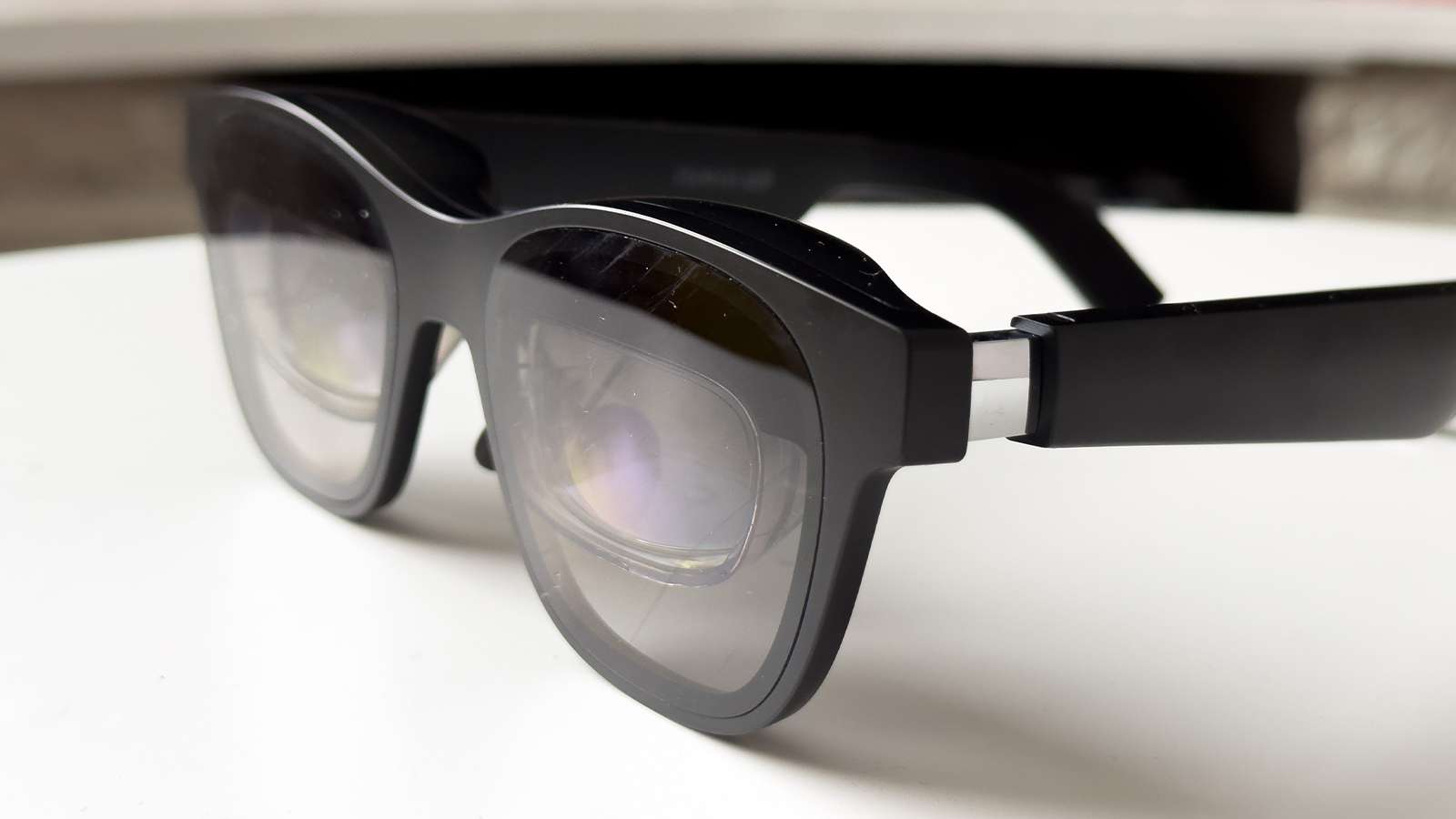
A pair of sunglasses that beam out a 130” “screen” in front of your eyes sounds like the future is here. However, Nreal Air made us yearn for more.
The future is here. Wearables have infiltrated our way of life, whether we like it or not. From Apple’s watches or the dozen fitness trackers out on the market, the only frontier not dominated right now is our eyes. Virtual reality is still a niche, while augmented reality wearables still linger on the outskirts of experimental.
Nreal’s Air glasses are the latest attempt to bring technology to our eyeballs. This a fascinating idea that has been done before, but never with this level of confidence. The Air is designed like sunglasses, with an OLED screen bolted to the inside and it bounces the image off a mirror to project a “130-inch screen” in front of you.
The Nreal Air isn’t the first time this type of device has come from Nreal either. The previous Light glasses also did something similar, but this time the Air comes without the “6DOF” tracking (six degrees of freedom) that is typically found in VR headsets. It does have 3DOF, for basic head tracking.
So how does this new, improved, but slightly scaled-back wearable do in a real-world setting outside of the idealized view of its marketing? It’s complicated.
Key specs
- Screen: OLED
- Resolution: 3840 by 1080 pixels with sRGB 108% color gamut, 8-bit depth for 16.773 million colors
- Brightness: Up to 400 nits
- Contrast ratio: 100,000:1
- Field-of-View: 45-degrees
- Projected image: 130″ at 4m (Screen mirrored), 201″ at 6m (In-app)
- 2 open-ear speakers
- Dual microphone array, omnidirectional MEMS microphones
- 3DoF head tracking
In the box: 4 nose pads, Case, Cleaning cloth, Detachable cable, Prescription-lens frame, 3 nose pads, Case, Cleaning cloth
Design
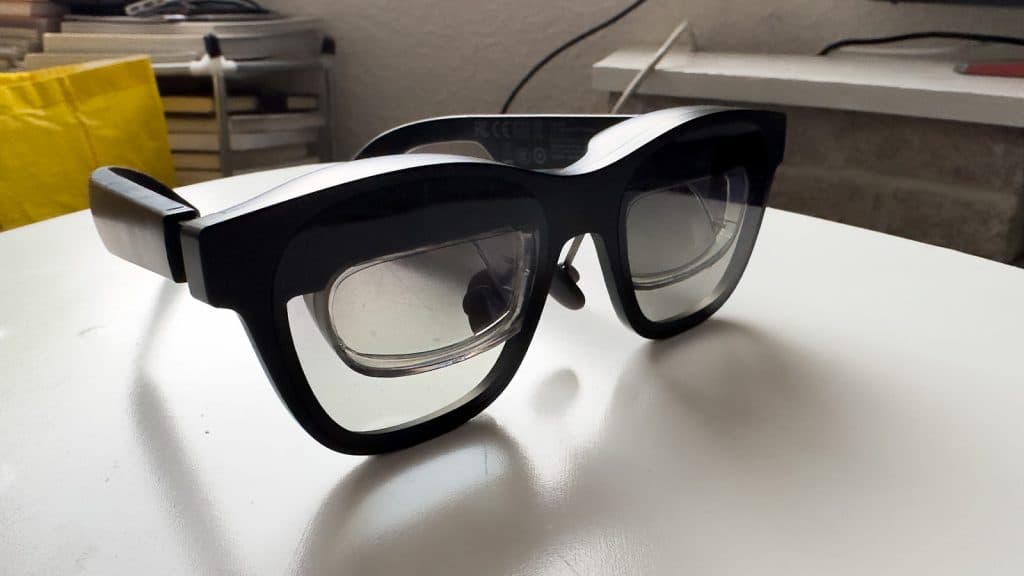
The overall look and concept behind the Nreal Air are fantastic. They might look a little thick to hinge entirely on your nose, but they’re legitimately quite comfortable. Everything is housed within the frame and arms of the glasses. The impressive side of its look is that it doesn’t overtly look like a piece of tech from the outside, instead just a massive pair of sunglasses.
The ingenious bit of its overall design is that one of the arms is your USB-C connector. We love USB-C, the all-in-one cable fits snugly into the gap and attempts to blend in as part of the arm. While you’ll have to wire stretching down from the phone, it never felt like it got in the way of using the device itself.
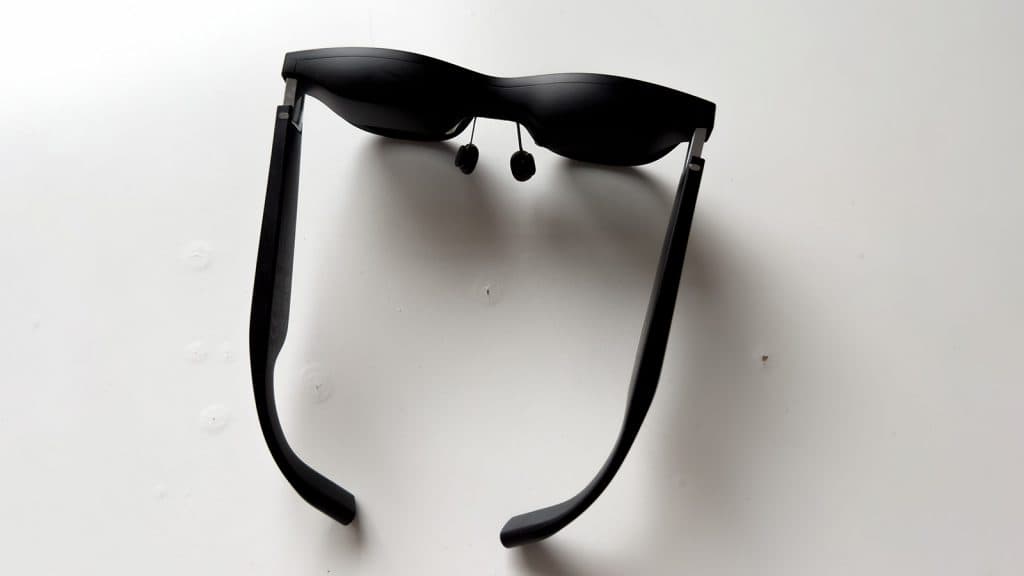
There’s just this high quality to the feel of the device which Nreal has nailed. It feels fantastic to put them on and see the screen in the distance. They never got too uncomfortable when lying on the couch or in bed with them blasting audio through the top of your ears.
However, despite a degree of excellence in the actual wearing of the glasses, it’s the software and use of the device that is Nreal Air’s biggest downfall.
Features
Embedded within the glasses is a 1080p OLED screen, which is beamed and reflected off of a pair of mirrors. It functions a little like a periscope, with a down-and-out method of seeing the image. It’s a great little screen, even when blown up to a massive size. Each detail is crisp, with no interfering aberration from plugging in a MacBook.
It makes for an excellent viewing experience as well, when paired with a decent set of headphones. Once you’re comfortable and in a semi to pitch black room, we sat through a whole episode of TV, a few YouTube videos, and messed about with the software on Android a little before having to remove them.
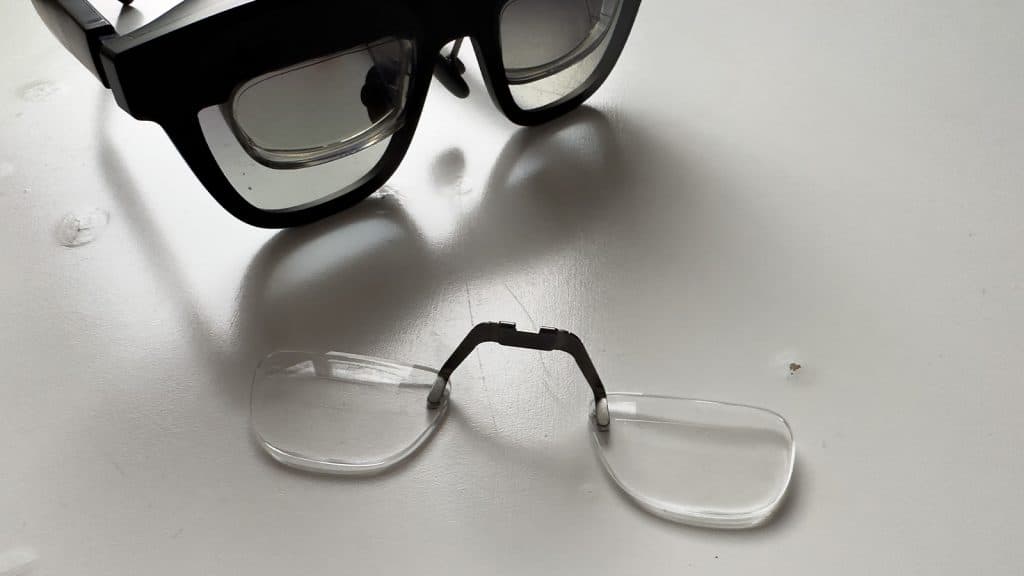
Everything that we just said is true, if you have eyes that function in that way. When giving the device to a friend to try out, who is long-sighted, they could comfortably see everything we described above, including a couple of YouTube videos. The technology does work, and it’s flawless, but for those of us with glasses, it’s a mess.
Nreal Air & glasses
Nreal does include an extra nose pad, one with two pieces of glass screwed in. You have to take those to the optometrist. Then pay the additional cost of getting a custom glass cut in your prescription. Then barbarically remove the metal connector to plug this one in with an almighty push. After, you can screw in the glass and use the device without glasses underneath.
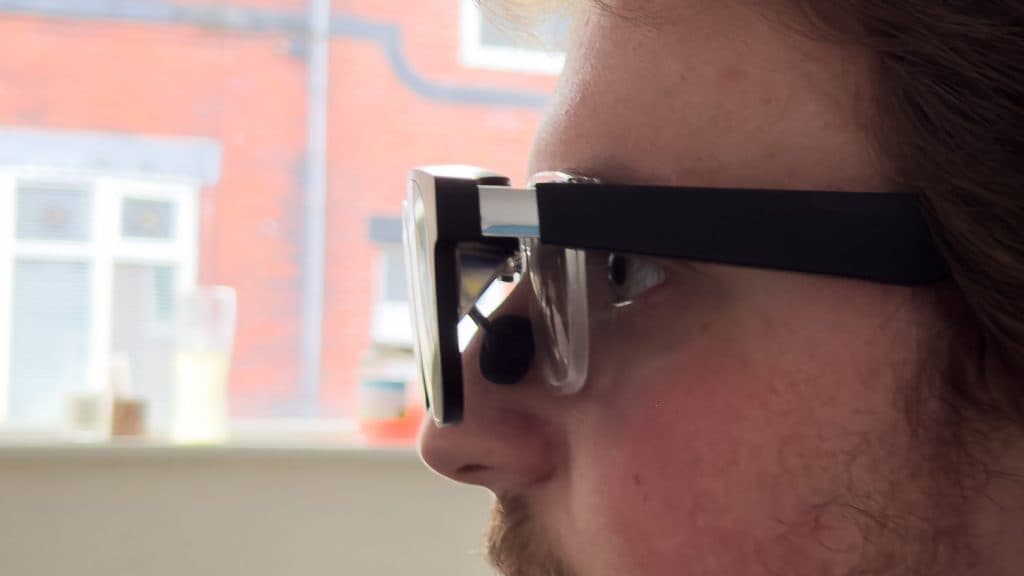 It’s not easy being short-sighted
It’s not easy being short-sightedWe didn’t have the funding for that, so we wore two pairs of glasses on top of each other, just so that it was possible to view the 130” screen it projects.
Not-so-smart glasses
Outside of a connector and probable microprocessor telling the screens to activate when plugging in a screen-mirrored device, there’s no software on the glasses themselves. It can’t power up without being plugged into something either.
Without any additional software to control the mirrored screen, those who might be shortsighted or hard-of-sight, are forced with an image they can’t control. Walking up to it doesn’t work, as it remains stationary on all axis in this mode.
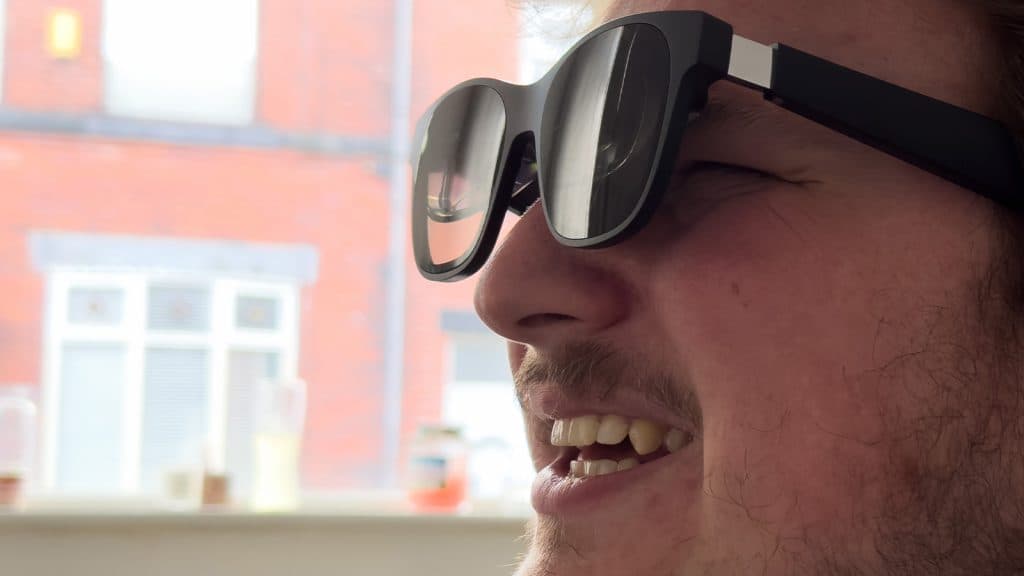 No glasses means a lot of squinting
No glasses means a lot of squintingOnly in the app, and in certain parts of the browser, can you zoom in and out to get a closer look at the content being presented. In screen mirroring mode, it projects fantastically, but we had to wear another pair of glasses to see anything clearly.
Nreal’s app is available in beta on macOS – but we couldn’t get it to work – or on Android. Nreal sent along a device preloaded with the required software, but it’s all available on the various app stores on the OS.
3DOF Tracking and FOV
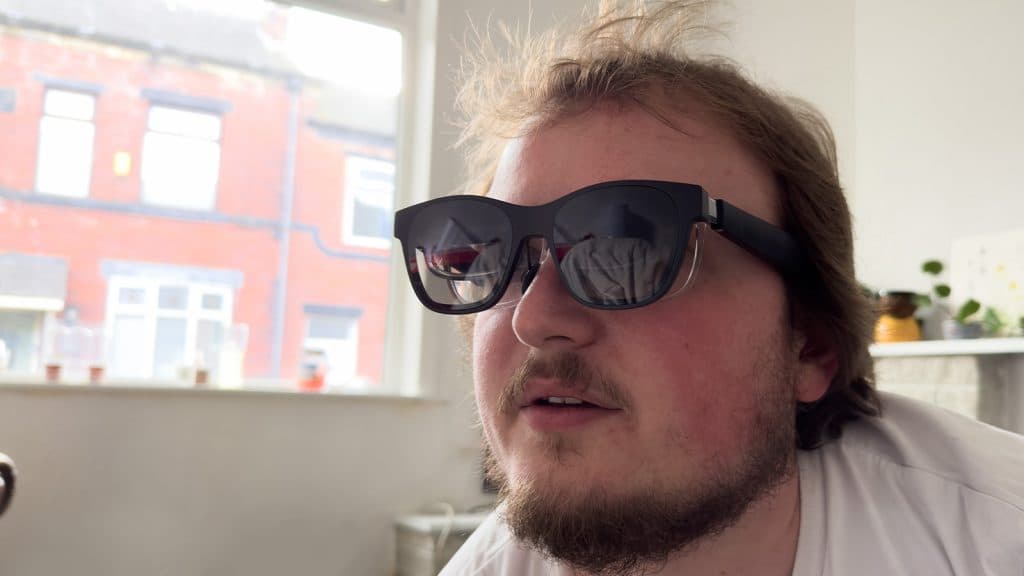
The Air specs don’t have 6DOF, so there’s no body tracking. Instead, there’s 3DOF, which will just track the head’s point of view. Everything is tracked on the phone, which becomes like a Wii remote for selecting apps or browsing.
Here you realize that the field of view is a meager 45 degrees. The menu feels like it should be split into pages to fit Nreal Air’s FOV, but instead is one large arch around the front of your head. You have to physically pan your head to see everything, with some light dragging to pull things back into view or changing around apps.
It functions for the most part, but we found the Nreal Air was very good at either losing track of things, or the app crashing and sending the glasses into a split screen tizzy.
As we moved around the room seeing how to break the tracking, we realized that we’d lost track of the menu. Spinning around to our starting position found that it had now begun to track upwards instead. We’re unsure if this is due to the glasses, or the app. We had to restart the whole app to get things back to normal.
Watching videos on Nreal Air
When things meshed and began to work, you can see the sparking hope that one day this might actually function correctly. Watching a video in the app is let down by the software that plagues the whole device.
YouTube videos would decide to not respond, but carry on playing. The 3DOF tracking is probably one of the worst ways to try to watch a video, as every minor tilt could send things spiraling out of control. Thankfully, you can set it to just “follow your eyes”, which limits things down to a mostly still image.
Getting a movie to load up was much easier and sacrificing the use of the device for a couple of hours was easier when switching to the highly limited screen mirroring mode.
Speakers
It’s not that the Nreal Air’s speakers are bad, it’s just a quick low bar way to ensure the device does everything all in one. They’re perfectly fine for TV or YouTube videos, but for gaming and movies, you’re best swapping to your preferred headphones.
Nreal Air compatibility issues
Even with its plug-and-play nature, and no real hurdles in the way of hardware we had on hand, it became incredibly obvious when we plugged it into another Android phone. The list of compatible Android devices is so slim, it immediately puts a niche into a further complex scenario. Showing these to friends and family became a chore, as screen mirroring mode on an iPhone with a $49 adapter became the easiest option.
Gaming performance
The built-in screen is only 60Hz, and it’s completely functional for gaming. There’s not too much latency between the two connections, especially on PC systems or the Steam Deck. The USB-C port is also DisplayPort enabled, so it’s a solid connection all the way through. We never had any problems with getting Windows or Linux to recognize the Nreal Air and it was quite literally plug-and-play.
It’s impossibly cool to play things like Black Mesa, Resident Evil 4, and Forza Horizon 5 in the glasses, with the blackout plastic, included helping immerse us entirely in the experience.
These are, however, much like the rest of the device subject to every errant beam of sunlight. Black Mesa and Resident Evil 4 became unplayable with the full plastic regalia blocking it out. Brightening up the glasses did very little other than make it more obvious.
Despite being designed like sunshades, these don’t do a very good job of preventing light leak. It’s like flood pants for Milhouse. “I can’t see anything, but my eyes are completely fine!”
The Verdict: 2/5
The Nreal Air is such a cool idea, as was the Light. However, no matter how you cut it, these are much better the more you strip back any of the additional features outside of “display video when plugged in”. When in screen mirroring mode, the conditions are perfect, and you’ve balanced both glasses on your face and ensured your headphones are on, they’re a solid way to watch or play things.
It is just the baggage that comes with them. They feel like a prototype of something that might not even come from Nreal. Wearables have come a long way, and in some cases, have mastered their particular body part. The eyes are the next great frontier and Nreal will be on the plaque of those who helped us get there – it just won’t be with this product.
If you click on a product link on this page we may earn a small affiliate commission.